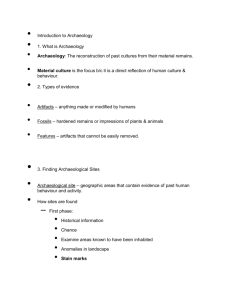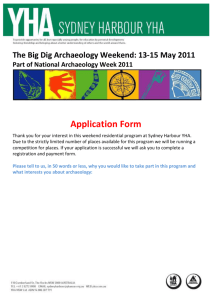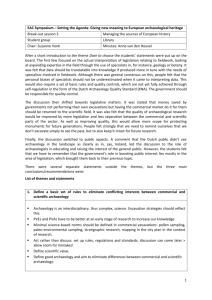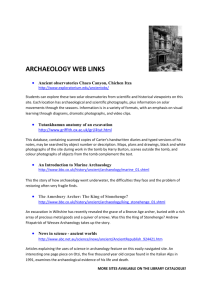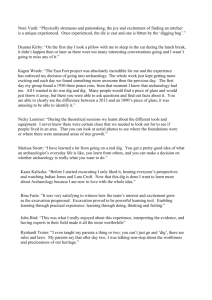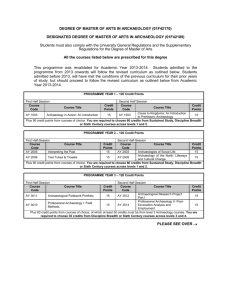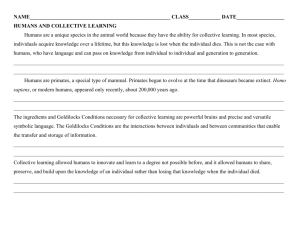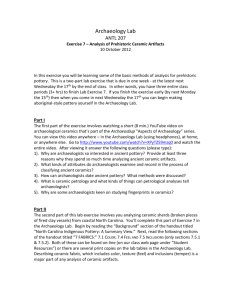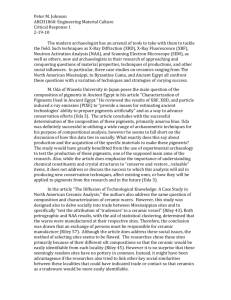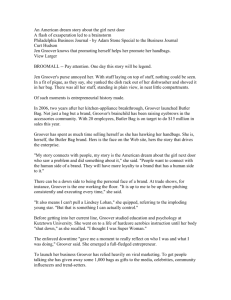November 29 response paper
advertisement
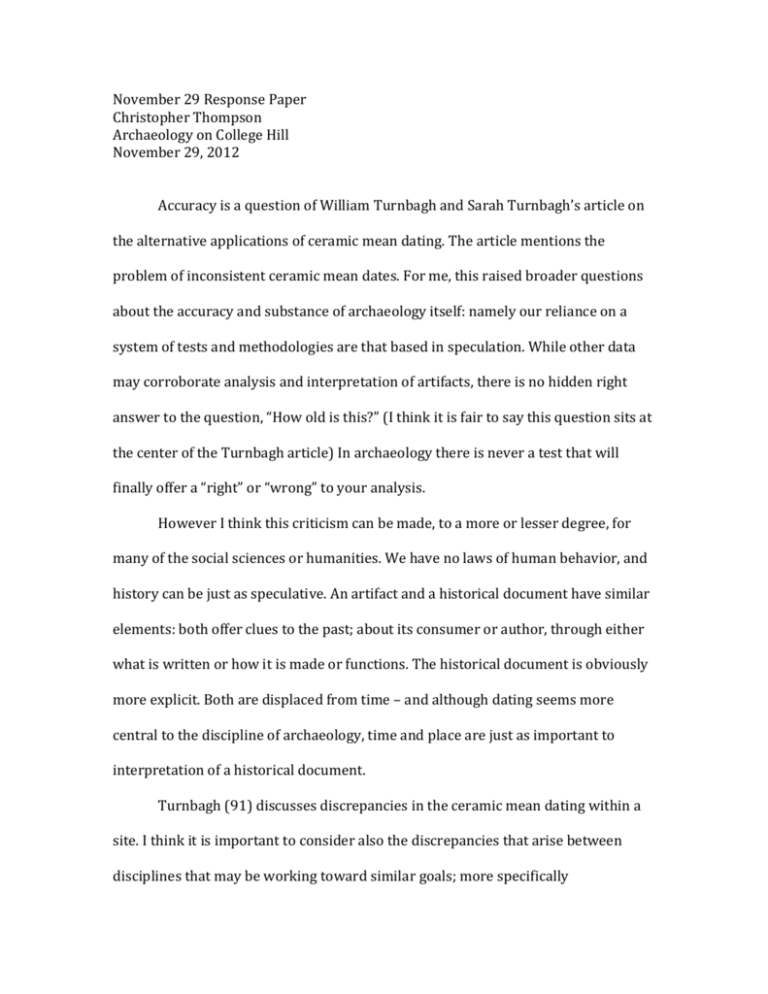
November 29 Response Paper Christopher Thompson Archaeology on College Hill November 29, 2012 Accuracy is a question of William Turnbagh and Sarah Turnbagh’s article on the alternative applications of ceramic mean dating. The article mentions the problem of inconsistent ceramic mean dates. For me, this raised broader questions about the accuracy and substance of archaeology itself: namely our reliance on a system of tests and methodologies are that based in speculation. While other data may corroborate analysis and interpretation of artifacts, there is no hidden right answer to the question, “How old is this?” (I think it is fair to say this question sits at the center of the Turnbagh article) In archaeology there is never a test that will finally offer a “right” or “wrong” to your analysis. However I think this criticism can be made, to a more or lesser degree, for many of the social sciences or humanities. We have no laws of human behavior, and history can be just as speculative. An artifact and a historical document have similar elements: both offer clues to the past; about its consumer or author, through either what is written or how it is made or functions. The historical document is obviously more explicit. Both are displaced from time – and although dating seems more central to the discipline of archaeology, time and place are just as important to interpretation of a historical document. Turnbagh (91) discusses discrepancies in the ceramic mean dating within a site. I think it is important to consider also the discrepancies that arise between disciplines that may be working toward similar goals; more specifically communication between archaeologists and historians. Julie Stein, in discussing the development of stratigraphy, mentions, “a large group of archaeologists studying urban centres came to the discipline [of stratigraphy] from an entirely different methodological direction. They explored the connections between archaeology and historical texts, languages, and classical periods” (Renfrew and Bahn 245) How common is this holistic approach to the past in academia? Based only a short discussion with my history professor, it seems that communication between the disciplines is often relatively alien and at odds. I understand this may come from an issue of trust: a researcher spends his or her life approaching the past in a specific way and he or she trusts the system of interpretation (or the system of criticism) that accompanies this. Conversely, if evidence from another discipline does not line up with your own research it is easy to discount the discrepancy as due to fundamental differences in approach. This limited conversation is not constructive. Turnbagh’s description of the Fort Independence archaeological site depicts the string of speculation I discussed above. Ceramic mean dating (a process that “must continue to be used cautiously” is used to date structures (the period of site occupation for Structure A is 1782.2—1829.5…). This analysis is then used to make even wider claims, (“the close correspondence of these values indicates contemporaneity of the structures [A and C].” (Turnbagh 96)) In this specific case, the initial mean dates of 1782.2 and 1785.0 seem a little too early for the 1803 fort, but other ceramic data dated to around 1800 points to association with the fort (Turnbagh 97). I don’t mean to say that archaeology is not valid or an accurate study, but rather, confront of the difficulties that face the archeologist. Difficulties, which naturally arise from the analysis of objects whose greatest clues lie in the context in which they are found. These difficulties are, of course, no reason to disregard the clues to the past that material culture holds. This also makes sense in consideration that harder sciences play in archaeology, whether biologic or geologic. I think this is a natural extension of the challenges that face the archaeologist, and harder science are able to unlock clues that may be preserved in the make-up of ancient fibers, or the shift in rocks over millennia. Archaeology is unique to many social sciences in its interactions with disciplines of science. This article on ceramic mean dating shows this well; Turnbagh is just as engaged with the implications of material culture, as she is with analyzing the inconsistencies of its mathematical formulas (Turnbagh 91). That four generations of the Gibbs family occupied the same piece of land for more than a hundred years has some very interesting implications (Groover 38). One consideration is that the artifacts found on the land can be, without too much doubt, attached to the Gibbs family. This presents an interesting comparison to the readings we did early on in the semester concerning ownership of the past. Although the kitchen material, architectural material, clothing, etc. probably holds little spiritual value compared to, say, an early colonial burial ground in central Cape Town South Africa, this does not invalidate questions of ownership of the past. Because we know that one family has lived on the same land for so long, the idea of a collective right to the past seems only strengthened. For example: if the house was owned by the Gibbs family from 1792 until 1971 at which point did their objects stop being property and start being artifacts? Is it when those objects started holding historical value? What is the relationship between time and a right to ownership? Groover (40) stresses the use of a diachronic approach to understanding households, specifically in terms of a household cycle. It is interesting consider this research continuing all the way up to the modern day. Considering our age of “information overload” what questions will historical archaeologists be asking about the period in which we live now? What will be the role of the excavation or survey when documentation of many, many objects is digitalized and shared online? What will be the use of the study of the past when the past has been not only well documented but so saturated with contemporary analysis? Is it that future researchers have the power of retrospection? Groover (41) discusses one aspect of the household cycle: namely the phases of growth and reduction as families grow with children and then shrink as those children, now adults, move away from home. I think the conclusions of this area of research must be studied against modern household cycles. The past does not stand alone in time, but offers insight into the present; we can ask what the causes and the implications are of a shift in household cycles all the way up to today. The diachronic nature of household cycles really stands at the center of the Groover article and its implications are reflected in the analysis of material culture found. This is a good example of processual archaeology, which offers evolutionary trends in cultural development; for example, the artifact distribution over time as corresponding to household size (Groover 47). It is interesting to consider the use of models in some parts of archaeology. William Hampton Adams (48) identifies “the introduction curve, the popularity curve, the curation effect, the heirloom effect…” and so on. This is a reflection of the nature of material culture. Quantity seems to play a central role in ceramic dating, and no doubt does in other segments of archaeological research (I remember the maps from Petra indicating areas of concentration of sherds and their quantity from specific time periods). It is interesting to think about the analysis of Adams and Turnbagh versus that of a historian. While a historian considers quantity of texts, or references in a work, quantity does not play the same role as it does in, say, Adams’ commentary on the “Dumping Effect.” (53)

